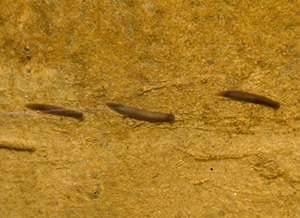 |
Cave Life of Mendip |
 |
| |
| HOME |
| INTRODUCTION |
| LIFE IN THE ENTRANCE |
| LIFE IN THE CAVE |
| CONSERVATION |
| GLOSSARY |
| ACKNOWLEDGEMENTS |
| Bacteria |
| Fungi |
| Plants, Algae & Protozoans |
| Flatworms |
| Eelworms & Segmented Worms |
| Slugs & Snails |
| Crustacea |
| Insects |
| Spiders & Millipedes |
| Fish & Amphibians |
| Birds |
| Bats |
| Fossils and archeology |
| |
Flatworms |
Flatworms are simple white or brown flattened worms and move about their damp habitat by a series of undulations. Most flatworms are free-living in streams and pools, but many are parasitic. Although simple they have a bilateral nervous system and the head end of some species even has a rudimentary brain to integrate signals from eyespots. Some have the ability to continue to grow as two flatworms when cut in half - the bit that had the tail grows a new tail and its tail becomes the head.
|
